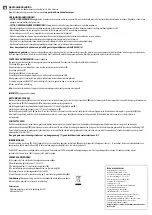
Getting Started
R&S
®
OSP
20
User Manual 1178.7100.02 ─ 05
Preventing overload on internal terminations
Overloading an electromechanical RF relay with internal port termination can damage
or destroy the relay.
The maximum load that the internal termination of one port can handle is approxi-
mately 1
W. However, if the relay has several terminated ports, their cumulative maxi-
mum load is less than the sum. For example, an SP6T relay with 6 internally termina-
ted ports cannot handle 6
W, but typically 3
W, only.
To avoid the risk of damage due to overloading internal terminations, limit the load to
the "Max. termination power per relay" that is specified in the
2.1.7
Connecting to Power
The switch unit is equipped with an AC power supply connector and can be used with
different AC voltages. The R&S
OSP adapts itself automatically to the voltage. Refer to
the data sheet for the voltage and frequency requirements. The AC power connector is
on the rear panel of the switch unit.
► Connect the R&S
OSP to an AC power supply using the supplied power cable.
As the switch unit's assembly is in line with the specifications for safety class
EN61010, you must connect it only to an outlet that has a ground contact.
For replacing the fuses, refer to
Chapter 12.1, "Replacing Fuses"
2.1.8
Connecting to LAN
The LAN connector (RJ45) of the R&S
OSP is on its rear panel, shown in
.
Network environment
Before connecting the product to a local area network (LAN), consider the following:
●
Install the latest firmware to reduce security risks. See
●
For internet or remote access, use secured connections if applicable.
For example, use HTTPS, SFTP, FTPS instead of HTTP, FTP.
●
Ensure that the network settings comply with the security policies of your company.
Contact your local system administrator or IT department before connecting your
product to your company LAN.
●
When connected to the LAN, the product may potentially be accessed from the
internet, which may be a security risk. For example, attackers might misuse or
damage the product.
For more information on how to connect the switch unit to the LAN, and for the IP
address, see
Preparing for Use
















































